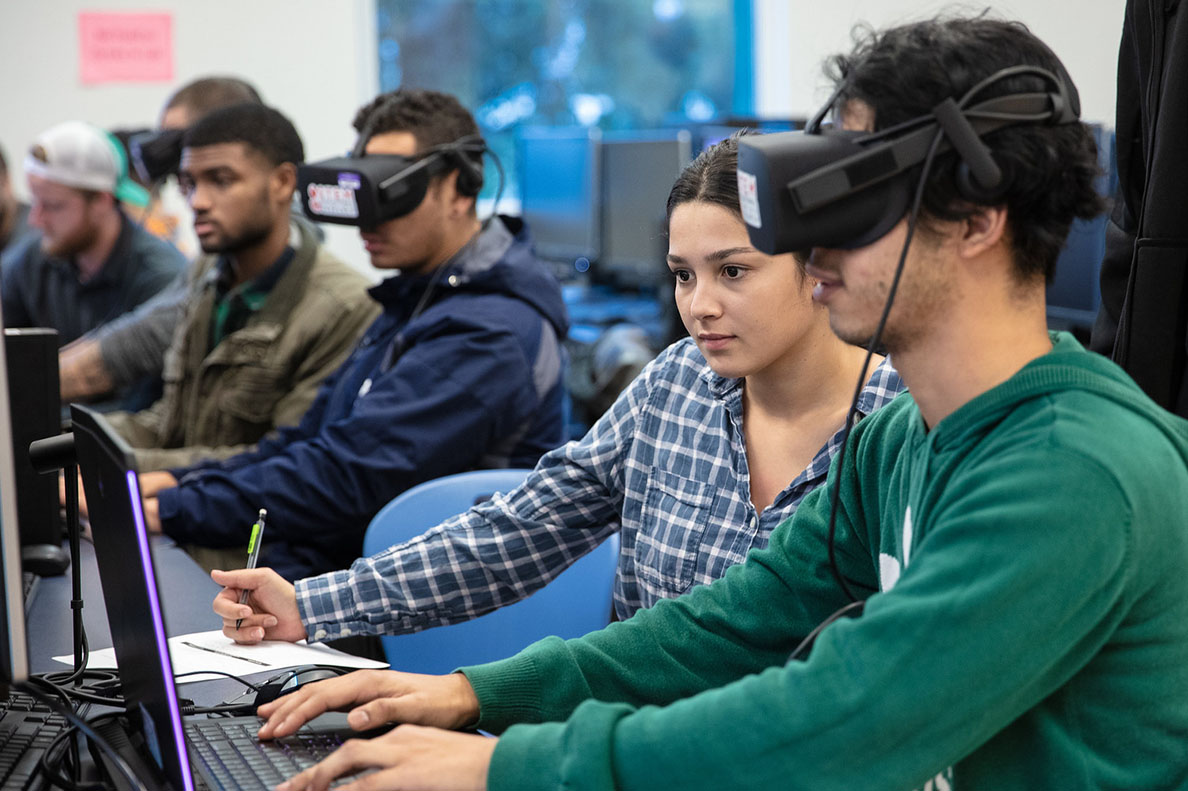
How to Catch a Mistake
- BY NATALIE FEULNER
- PHOTOGRAPHY BY NATALIE FEULNER
- December 14, 2018
In a classroom on the second floor of the Valley Business and Technology building, Assistant Professor Fadi Castronovo’s construction management students pair off, half wearing headsets, the other half watching the computer screen in front of them. The students wearing the headsets turn their heads left and right, turning toward virtual walls and sharing mistakes.
“There are no handrails on these stairs,” says one.
“I think there’s something down this hallway,” wonders another.
The students are working with virtual reality, a tool many of them, if not all, will need to master before graduating and seeking jobs in the construction industry.
“I am trying to not only teach the students the technology but improve the teaching process and evaluating teaching engineering using VR,” Castronovo said. “My hypothesis is they will be able to find more mistakes using the technology [compared to paper architectural drawings or blueprints.]”
THE RISE OF VR
Thanks to the affordability of and access to the technology required, virtual reality is playing an increasingly important role in classrooms nationwide. According to Forbes, since 2012, the number of active VR companies has grown by 250 percent.
And Forbes magazine said VR is becoming more common in the workplace, replacing everything from paper training manuals to conference calls.
Virtual reality creates safe and controlled testing and training environments, it can allow new hires to “visit” the workplace in a hands-on way without requiring travel and it can unify geographically diverse workplaces, the magazine said.
In addition, a study published in the Journal of Construction Management and Economics showed that VR was more effective at maintaining construction trainees attention and more effective over time compared to traditional methods.
Castronovo’s own study published at the International Conference on Construction Applications of Virtual Reality showed the use of VR in engineering allows project teams to collaborate and visualize information to reduce design flaws and construction mistakes].
Castronovo said that rings true for his students as well.
“The feedback is there, they like being immersed, it provides an environment for the students to be activated, engaged in the work and having fun doing it,” he said.
AVOIDING MISTAKES
A flawed structure design is not only time consuming to fix, but it can also be costly and sometimes fatal. Errors can range in size from small shifts in a foundation found after a building is completed to shifting skyscrapers such as the Millenium Tower in San Francisco, which has sunk 17 inches and tilted 14 inches since opening in 2009.
But how can virtual reality help?
According to Connect and Construct, creating a 3D model of a construction site requires space, time and materials. And while helpful, models can contain inaccuracies and lack detail. Virtual reality, however, allows people — architects, construction managers and clients alike, to not only create a more detailed model but immerse themselves and interact with the design exactly as they would during a walk-through.
“I was most surprised about how dizzy you can get if you’re not careful.”
That process of analyzing is usually done on 2D and not everyone in the process is trained to think in two dimensions which can create a disconnect between what is on paper and what will be built.
But with VR, teams are able to “see” a project without having to travel to the site, and since a virtual reality experience require little to no knowledge of engineering and design, clients are able to evaluate for themselves how a design might work for their company.
A dizzying learning curve
For some of the students, the classroom experience was the first time they’ve dabbled in virtual reality. And there was a bit of a learning curve.
“I was most surprised about how dizzy you can get if you’re not careful,” said student Samantha Sanchez.
Castronovo had told the class at the beginning of the activity that a prize was on the line for the pair that found the most mistakes. Sanchez, one of only two women in the class, was determined to beat the previous record of 19 mistakes found.
“I was eager to find the most construction building mistakes and was moving too fast and got dizzy right away and had to take a break for a second,” she said.
But once mastered, “walking” through a design instead of looking at it all at once in a drawing, made the potential for dizziness worth it. At least according to student Francisco Cardona who said while he’s had plenty of experience evaluating traditional 2D drawings, he felt the VR made it easier to spot mistakes.
“I think VR [in construction management] is in its early stages, but construction is always evolving and I think it could be the next big leap,” he said adding he is hopeful the experience will help him with future career prospects. “I think I need more training … but I think the fact that I have been exposed to VR will set me apart from other students.”